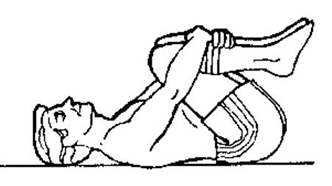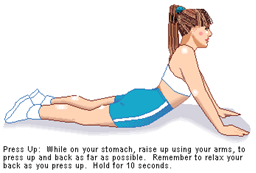Neck and Back exercises as a means for diagnosis (197)
Neck and Back exercises as a means for diagnosis
蘇鎮邦 (Christopher So):
舒整物理治療師 (Manipulative Physiotherapist) 人類工程師 (Ergonomist)
From the following three exercises, you may be able to tell whether you have problems.
The first one is rotation exercises. Referring to the diagram, you lie on your back and bend your knees up to about 60 degree. Keeping your legs and feet together, you turn them from side to side slowly and smoothly. When you are turning, you must be careful not lift your legs and feet up because this will put a lot of pressure on your back. It is common to get sore after doing the exercise rather than during it. You won’t know that you are doing it wrong. This will cause the back problem to get worse. In addition, the reason why you lie down is because it will stabilize the chest or thoracic area so that the turning will focus on the lower back or lumbar area. You turn only to the point of pain arises or when the shoulder on the opposite side starts to lift off. This is your end of lumbar rotation. If you turn too much, not only does it involve the thoracic spine it can cause increase of back pain. 30 repetitions to each side suits most people. However, if you feel tire or sore earlier, you should stop.
With my 33 years of experience as a physiotherapist, I suggest that if you are under 30 years old, normally you should be able to touch the floor with your knees (i.e. 90) without lifting the opposite shoulder. If you are between 30 -50, you should be able to turn at least 60 degree to either side. If you are over 50, then you still should be able to turn to about 45 degree. I have been doing this exercise since I was 40 years old, now I am 50 years old, I still can touch the floor on both sides. If you do not have a normal range of rotation, it is advisable to see a physiotherapist to check it out.
The second exercise will help your back bending forward. You lie on the floor with a pillow under your head and bend your knees up to your chest. You use your hands to pull the knees forward and backward gently. This will help to stretch your back. This has the advantage over bending down from a standing position because it stretches the lumbar spine from the bottom first. Also it is safer because you cannot fall from the floor. Moreover, the body weight pressure on the spine and discs is two to three times less than standing. In Ergonomics, safety is the first principle. When you bend your knees up, keep your head relax on the pillow in order to avoid strain on your neck muscles. When you bend your knees up, do not turn from side to side because this will put too much stress on your spine. Again, you may not know it is harmful during the exercise as commonly the pain may start after the exercise. Then, it may be too late. If you do not do it correctly, it may cause more pain. 5 stretches each repetition and 10 repetitions each time.
If you are 30 years old or younger, you should be able to touch your chest with your knees. If you are between 30-50 years old, you should be able to bend it up from 90 degree to 60 degree towards your chest. If you are older than 50 years, it would be good if you can bend it up to 45 degree. Even I am over 50 years old, I can still touch my chest with my knees. If you do not have a normal range of rotation, it is advisable to see a physiotherapist to check it out.
Bending your back backward is the movement that older people most commonly lose. It is because many daily activities require people to bend forward, especially with modern computer equipment, while very few activities require people to bend backward. This is especially true for those who work all day in the office and do not have enough sports or exercises. A lot of people go to the gymnasium to do exercises. However, they do not realize that most of the exercises only help to build up their muscle strength but not their mobility, unless they do some aerobic exercises or calisthenics. Therefore, it is very important to play some racquet sports or swimming. It is medically proven that exercises can improve your mental health so why not?
The third exercise is helping to improve backward bending of your back or spine. Lie on the ground and do a modify push up, meaning you only push up with your hands keeping the legs from waist down on the floor. You should stop when your tummy start to lift off the floor. At that point, you should hold it for ten seconds or a count of ten. If you breathe out, you will feel that your spine will sink down a bit more and sometimes with slight soreness. If it is too sore then do not breathe out. You have to do 10 repetitions twice a day which is for maintenance. If you have back pain, this exercise may cause increase of pain. It may better for you to do it at a later stage when you back pain has settled without too much spasm. If you have any doubt, you should consult your physiotherapist.
The above exercises have not been medically proven but are recommended from my clinical experience. It is for your reference. For people without back pain, they can be used for maintenance of good back movements. Generally, if you can do it in the morning and before you go to bed, that is sufficient. If you have back problems, then you may need to go it four times a day to make your back pain better faster. Usually, these exercises may not have immediate effect. It may take a few weeks before any obvious effect can be felt.
Finally, this is a general advice and there are many kinds of back problem. If you feel they make you worse or do not help your back problem, you need to consult your own local physiotherapist for further investigation.



